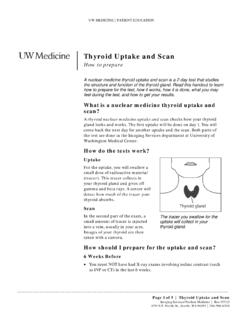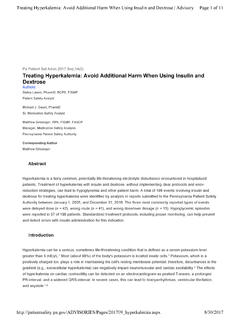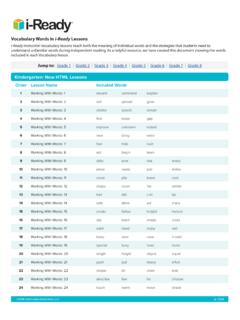Transcription of What is Yttrium-90 radiotherapy? DRAFT - UW Medicine
1 UW Medicine | PATIENT EDUCATION. || Angiography: Yttrium-90 Radiotherapy || Treatment for liver tumors This handout explains what Yttrium-90 radiotherapy is and what to expect when you have it done. What is Yttrium-90 radiotherapy? Yttrium-90 is a radioactive substance. It is used in radiation therapy (radiotherapy) to treat cancer. DRAFT . Why do I need this treatment? Your doctors have found a tumor (or tumors) in your liver. These may have started in your liver (hepatocellular carcinoma) or spread to it from another part of your body. There are many treatments for liver tumors, but certain ones work best for certain people. Our team of experts believes that Yttrium-90 (Y-90) radiotherapy is the best option for you at this time. Y-90 radiotherapy sends radiation directly into the blood vessels that feed the tumors.
2 This treatment does not cure liver tumors. But, it often controls or shrinks them. After this therapy, your doctors may advise other options such as chemotherapy or surgery. How does Y-90 radiotherapy work? External radiation therapy is used to treat many types of tumors. But, the doses of external radiation needed to kill liver tumors would seriously harm the healthy parts of the liver. In Y-90 radiotherapy, millions of tiny radioactive beads are injected directly into the arteries that supply blood to your tumor. These beads will stay in the blood vessels around your tumor(s). This Tiny radioactive beads are inserted into allows very strong radiation to your arteries through a catheter (tube). reach the tumors directly. _____. Page 1 of 8 | Angiography: Yttrium-90 Radiotherapy UWMC Imaging Services | Box 357115.
3 1959 Pacific St., Seattle, WA 98195 | The beads emit radiation for about 10 days, but they will keep working for several months after they are injected. There is very little effect on healthy parts of your liver or other tissues in the area such as your intestines or skin. Y-90 radiotherapy is also a minimally invasive treatment. This means that only small medical tools are used and your body is not opened up. This means your body will recover more quickly than it would after regular surgery. What beads are used in Y-90 radiotherapy? The beads used in Y-90 radiotherapy are made of either plastic or glass. Two types of beads can be used for this treatment: SIR-Spheres are approved by the Food and Drug Administration (FDA) for people with tumors in the liver that have spread from colon DRAFT .
4 Cancer. TheraSphere is approved as a humanitarian use device (HUD) to treat hepatocellular carcinoma. An HUD is a device that has been approved for treating a small number of people with a specific health condition. Both TheraSpheres and SIR-Spheres have been used safely and effectively in thousands of patients with liver tumors. We will choose the type of bead that will work best for you. How is the procedure done? Y-90 radiotherapy is done by an interventional radiologist, a doctor who specializes in procedures that use X-ray guidance. The treatment is done in several steps over a few months. Step 1: Mapping Angiogram Step 1 is a procedure called a mapping angiogram. It takes 2 to 4 hours. During this procedure: You will lie on an X-ray table. The only discomfort you will feel is a short burning feeling when the local anesthetic (numbing Medicine ) is applied to your skin.
5 A small plastic tube (catheter) is put into an artery in your groin and threaded to the liver arteries. X-rays will help your doctor guide this catheter to the right place. Angiograms (X-ray pictures) are done to help your doctor see how blood flows to your liver. This will tell your doctor if we can use Y-90. therapy for you. If the angiogram shows that Y-90 therapy: _____. Page 2 of 8 | Angiography: Yttrium-90 Radiotherapy UWMC Imaging Services | Box 357115. 1959 Pacific St., Seattle, WA 98195 | Is not possible for you, the procedure will end. Is possible, your doctor will go ahead with the next steps. Your doctor will use small metal wires (coils) to block off blood vessels that should not receive radiation. A harmless tracer agent will be injected into your liver arteries. The angiogram shows how much tracer enters the tissues around your liver.
6 Then, you will be taken down the hall to the Nuclear Medicine department for a scan. This scan will show how much of the tracer has left your liver and entered your lungs or other organs. If the scan shows: Too much tracer in the tissue outside your liver, Y-90 treatment will not work for you, and the procedure will end. Little or no tracer in the tissue outside your liver, you will be approved to go to Step 2. DRAFT Step 2: Y-90 Infusion If you are approved for Y-90 therapy after Step 1, your precise dose of radiation will be calculated and delivered to the hospital at a specific time. About 2 weeks after Step 1, you will have a 2nd procedure. Another catheter will be placed in the artery in your groin. Like the last time, the catheter will be threaded to your liver. The beads coated with Y-90 will be slowly injected into your liver artery.
7 This procedure takes about 1 hour. Step 3: 2nd Y-90 Infusion (if needed). We often treat only half of the liver in Step 2. If you need a second Y-90. infusion to treat other parts of your liver, you will have another Y-90. infusion session 4 to 6 weeks after Step 2. Step 4: Scans About 1 month after your last Y-90 infusion, you will have a magnetic resonance imaging (MRI) or computed tomography (CT) scan. This scan will show how the tumors have responded to the treatment. Your doctor will review your scans, blood test results, and overall health. Your doctor will talk with you about any other treatments, if needed. Are there any special precautions I need to take after the Y-90 infusions? The radiation released by the Y-90 beads travels less than inch. But, your doctor may restrict your activities after treatment.
8 Depending on the type of treatment you have, you may need to limit your contact with others for a short time. _____. Page 3 of 8 | Angiography: Yttrium-90 Radiotherapy UWMC Imaging Services | Box 357115. 1959 Pacific St., Seattle, WA 98195 | Are there any risks or side effects? The most common side effect after Y-90 radiotherapy is fatigue. This can be mild or severe. It can last up to a few weeks. Other side effects include: Poor appetite Mild abdominal pain Slight fever Nausea These symptoms should slowly go away over 1 to 2 weeks. There are other much less common but sometimes serious side effects and problems. Your doctors will talk with you about these risks before you DRAFT . start treatment. Please ask any questions you have and make sure all of your concerns are addressed before you begin Y-90 treatment.
9 Before Your Procedure Arrival time. If you are an outpatient (not staying in the hospital), a nurse coordinator will call you the afternoon before your procedure. If your procedure is on a Monday, the nurse will call you the Friday before. The nurse will: Tell you when to arrive at the hospital Give you reminders about what to do on the morning of your procedure Answer any questions you have Interpreter services. If you do not understand English well enough to understand these instructions or the details of the procedure, tell us as soon as possible. We will arrange for a hospital interpreter to help you. A family member or friend may not interpret for you. Blood tests. You most likely will need blood tests done in the 14 days before your procedure. Sometimes, we do your blood tests when you arrive for your procedure.
10 We will let you know if a blood sample is needed before that day. Allergies. If you have a history of allergy or bad reaction to contrast (X-ray dye) or other products that contain iodine, please call our nurse at one of the phone numbers on the last page of this handout. You may need Medicine for this allergy before the procedure. Kidney health. If your kidney function is not normal and we need to give you contrast, we may prescribe a Medicine for you to take before and after your procedure. This Medicine will help protect your kidneys. _____. Page 4 of 8 | Angiography: Yttrium-90 Radiotherapy UWMC Imaging Services | Box 357115. 1959 Pacific St., Seattle, WA 98195 | Blood-thinning medicines. If you take any blood-thinning medicines such as Coumadin, Lovenox, Fragmin, or Plavix, you may need to stop taking the Medicine for 3 to 9 days before your procedure.

















